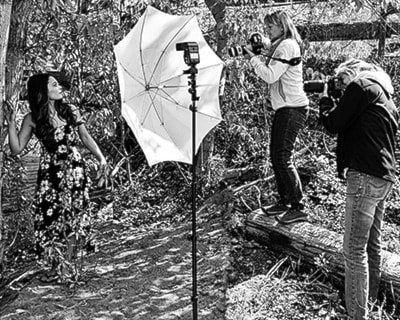I like using flash. I know that really isn’t surprising to regular readers. Like most beginning photographers there was once a time that I thought the only circumstance to use a flash on my camera was when it was too dark to take a picture.
When I first began taking pictures for others I dreaded late afternoon events that forced me to shoot in low light. And when Kodak and Ilford introduced their 1600 and 3200 ISO films I joined others in applauding, and ignorantly thought I could forgo ever having to attach a flash on my camera again.
However, although those amazing films would let us capture our subject in limited light, the side effect was nasty grain that was almost as bad as push developing film.
For those that don’t know what the term “pushing developing film” means, photographers would, for example, rate their 400ISO at 800ISO and double the development time to achieve a more sensitive emulsion - grainy as the outcome was.
When I looked into what successful portrait photographers were doing with flash I knew I needed to move out of the natural light rut. So I began the struggle to learn how to employ flash any time I photographed people.
However, it was noted photographer, Dean Collins, whose writings and classes opened the doors to using off-camera flash. He was the first that pulled me out of what he called the “artist” mode, and got me thinking about photography as a craft. He wrote, “Anybody who says that photography is 95 per cent feeling and five per cent technique is a coward.”
Before I learned about wireless flash, I would connect and splice wires together so I could use my flash on a light stand at some distance.
To get the proper off-camera light one would go through lots of calculations. There wasn’t a digital LCD on the back of a film camera. With trial and error I came to know that my old manual flash, with a folded men’s white handkerchief covering it, would give me a nice soft, diffused light at 10 feet.
Olympus introduced the first TTL (through-the-lens) flash metering in the 1970s and other manufacturers followed soon after.
I began using Nikon’s early TTL, the SB16, on a Nikon F3 and my world changed - no more clumsy calculations. I have been a fan of TTL since then and with every camera upgrade I also upgraded to the latest technology in TTL flash.
When using manual flash, there is no control by the flash or camera; the light is simply a constant amount of light that’s emitted from the flashgun.
With TTL flash, the output is controlled by the camera’s metering system, and is not a constant amount of light emitted from the flashgun.
I have used TTL flashes on and off-camera since the late 1970s.
Taking nothing for granted I read everything I could find, and took as many classes as I could get to figure out the best way to use TTL flash, and after all these years I am pretty comfortable using TTL in any condition.
I constantly try to convince and help others to stop being lazy and to include flash when they make portraits indoors or out, and for many years I have lead sessions for those photographers that decide to take the step to using off-camera flash.
The included image is of participants in my last one-day workshop on using TTL flash off camera in daylight. I will steal the words of probably the most famous teacher, lecturer, and author, Joe McNally, and say that the best part of spending the day with those willing photographers that joined me on their adventure into shooting under the sun with flash is, “The moment it clicks.”
These are my thoughts this week. Contact me at www.enmanscamera.com or emcam@telus.net. Stop by Enman’s Camera at 423 Tranquille Road in Kamloops.
And if you want an experienced photographer please call me at 250-371-3069. I also sell an interesting selection of used photographic equipment.
